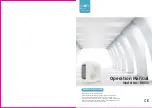
21
INSTALLATION
PRECAUTIONS TO TAKE FOR UNITS USING R410A
Conditioners that use R410A refrigerating gas require particular attention when they are installed
and serviced in order to safeguard them against faults caused by the pecularity of the gas itself.
Remember to take the following precautions!
• For all units that operate with
R410A
, it is obligatory to set the lines and the interior unit in a vacuum before the
cocks of the exterior unit are open.
• Specific equipment, different from that used for
R22
, is required for the vacuum and charging operations (
mono-
metric unit, hose pipes, etc.
) since it contains oil residues that are not compatible with the oil used in
R410A
units. An exception to this is the vacuum pump since a non-return valve has been added to this and acts if the pump
accidentally turns off during the vacuum operations.
• Make sure that there are no traces of water in the cooling circuit.
• Do not use the charging bottle since the composition of the gas mixture could change when this instrument is used.
• All charging or topping up operations must be carried out with
R410A
in the liquid state. A bottle that draws from
below and an electronic scale are required for this type of operation. This allows the liquid coolant to be always
drawn from the lower part. To prevent the mixture from fractioning, it is advisable to use
R410A
gas bottles up to a
30%
residue level.
• If there are consistent coolant leaks from the cooling circuit, do not top up partially as this could modify the com-
position of the gas mixture but completely discharge the machine and recharge it with the required quantity after
having carried out the vacuum operation.
PIPE CLAMPING
Make sure that the connecting zone is free from dust and dirt.
• Make sure that the flare and connection are perfectly aligned.
• Tighten the union first by hand and then with an adequate torque wrench.
Leaks could occur if the parts are insufficiently tightened, while the flare could be damaged if it is tightened too strongly.
The table below lists the torques recommended for the various pipe diameters.
Nominal
diameter (")
Outer
diameter (mm)
∅
Torque (N·m)- (kgf·cm)
1/4
6.35
14 ~ 18 (140 ~ 180)
3/8
9.52
33 ~ 42 (330 ~ 420)
1/2
12.70
33 ~ 42 (330 ~ 420)
5/8
15.88
33 ~ 42 (330 ~ 420)
Torque table (Reference values)
Содержание midas pc10
Страница 110: ...NOTE ...
















































